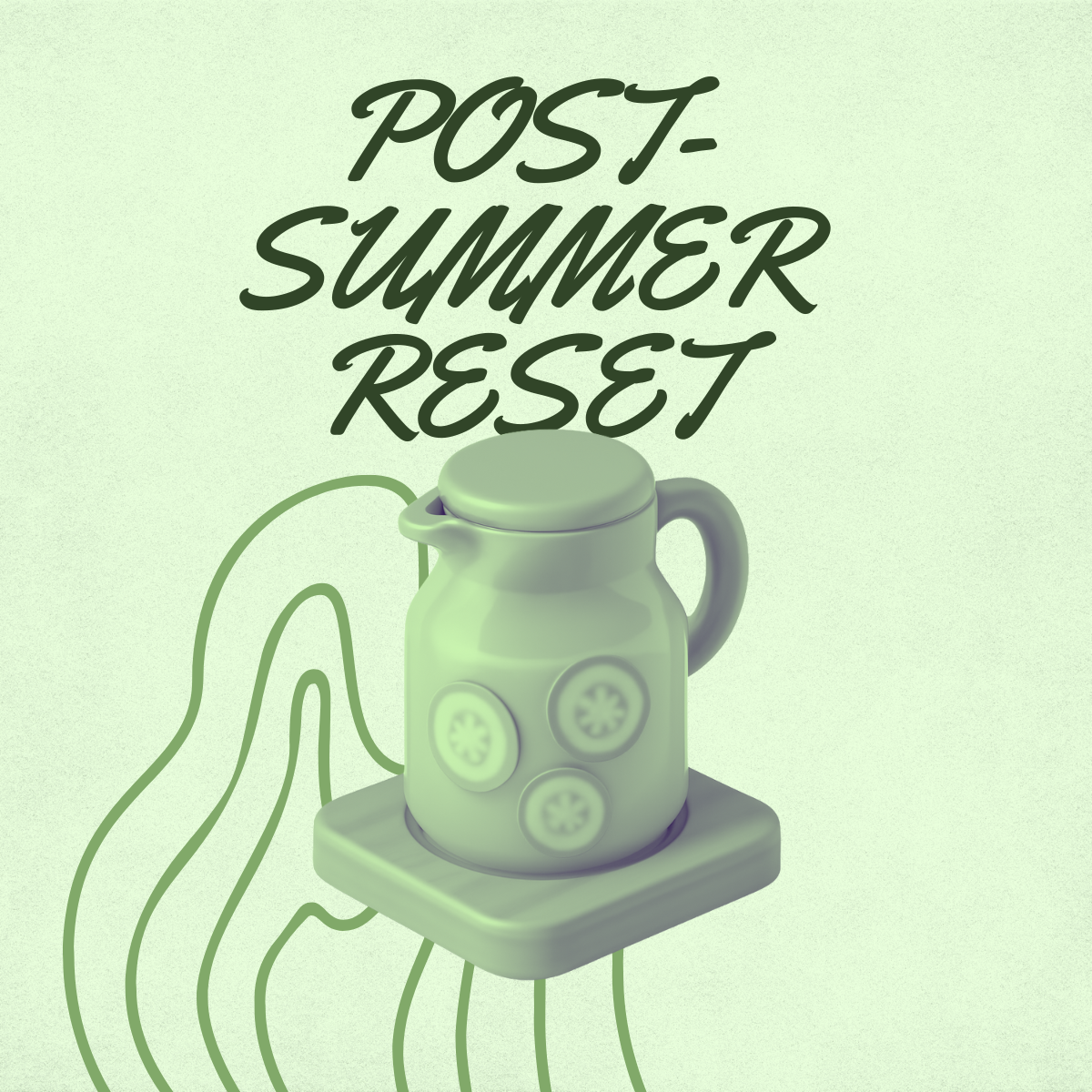
September rolls around and suddenly you're staring at your knowledge base analytics like it's a puzzle missing half its pieces. The numbers are...well, they're not great.
Traffic has dipped, feedback has practically disappeared, and that once-thriving self-service operation feels more like a ghost town than a bustling help center.
Sound familiar? You're not alone 😊
Here's what we know from our data: knowledge bases typically see a natural traffic recovery as teams return from summer breaks and customers re-engage with products and services. Our State of Knowledge Base Traffic 2025 report reveals exactly how this recovery pattern unfolds.

But here's the thing that caught us off guard in our research: while your users are getting ready to ramp back up, you and your team are probably still stuck in that summer fog.
Let's fix that together.
Quick start checklist
Feeling overwhelmed? Start here:
- ✅ Export 3 months of analytics data from your dashboard
- ✅ Identify 3 quick wins (broken links, outdated info, obvious gaps)
- ✅ Fix one small thing today to build momentum
- ✅ Block 2 hours this week for bigger improvements
- ✅ Document what you learn so you don't lose it again
Completed all 5? You're already ahead of most teams! Keep reading for the strategic approach.
The Double Slump Nobody Talks About
Here's what creates the perfect storm: your users took a summer break, your team took a break, and now everyone's supposed to magically snap back to peak performance.
Spoiler alert: that's not how brains work 😭
Research from McKinsey Global Institute shows that employees already spend 1.8 hours daily searching for information. That's nearly 10 hours per week, or having one out of every five team members permanently "off duty" just hunting down answers.
When teams are operating in post-vacation mode, that number gets even worse.
The psychology is simple: after extended downtime, we lose momentum, context, and that mental map of where everything lives. It's like a robot vacuum that's been moved to a new room (or gets stuck behind the door 😒). It needs time to reorient and figure out where the obstacles are.
But here's the really encouraging part: IDC research shows that a 1,000-employee company wastes $2.5 million annually due to poor information access.
That's over $200,000 per month in lost productivity just from people searching for stuff! Even if you're working with a smaller team, these principles absolutely scale.
A 100-person company could be losing $20,000+ monthly to information chaos. The opportunity to make a real difference is huge. You just need to approach the recovery thoughtfully and strategically ✨
Step 1: Export Your Analytics (Don't Guess, Know)
Before you start randomly updating articles or restructuring your entire knowledge base (we've all been there!), take a breath and look at what's actually happening.
Find Your Traffic Patterns 🚦
Where did people actually go when they visited? Which articles saw the biggest drops? More importantly, which ones held steady or even grew during the slower period? HelpDocs' flamegraphs can give you a quick overview.
Decode Your Feedback Trends
Those feedback ratings in your articles aren't just vanity metrics. They're like having thousands of mini-conversations with your users. According to Gartner's 2024 research, only 14% of customer service issues get fully resolved through self-service, but when customers can find what they need, satisfaction jumps by 45%.
Analyze Your Search Gaps
This is where HelpDocs' search insights really shine. What were people actually searching for? The gap between what they searched for and what they found is your roadmap for improvement. You can see the exact terms people used and whether they found helpful results.
Check Content Freshness
HelpDocs lets your team flag content that might be getting stale using, well, our Stale feature. If your team is using the Stale feature, now's the time to filter your content. Outdated information doesn't just frustrate users. It actively undermines trust in your entire knowledge base.
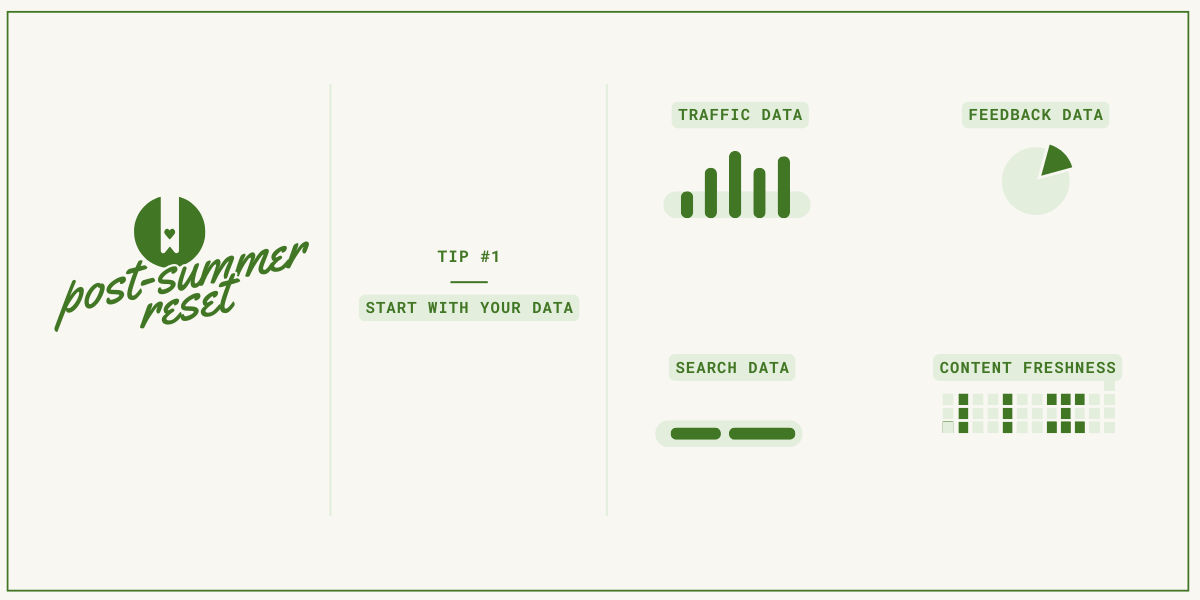
Step 2: Let AI Help You See Patterns
Here's where AI can be your secret weapon, and this is something we're really excited about. If you're already using AI tools for product management or content creation, try uploading your exported HelpDocs data to them. Ask specific questions like:
- "What patterns do you see in the negative feedback comments?"
- "Which topics seem to have the biggest gaps between what users search for and what they find?"
- "What are the common themes in articles marked as stale?"
The insights you get might surprise you! Sometimes the problem isn't that you need more content, it's that your existing content isn't organized in a way that matches how people actually think about their problems.
Turn Your Q2 Lessons Into Q4 Fuel
Every knowledge base team learns things the hard way during their first busy quarters.
Maybe you discovered that your article approval process was too slow. Maybe you realized that certain topics generated way more questions than others, or that your team struggled to keep up with product updates.
Those weren't failures, they were lessons. Now it's time to cash them in! 💪
Audit Your Workflow Bottlenecks
Look back at Q1 and Q2. Where did things consistently get stuck? Common bottlenecks we see:
- Articles getting abandoned halfway through: Sound familiar? You start updating your API documentation, get pulled into three meetings, and two weeks later it's still sitting in draft mode with a note that says "finish later."
- Meetings eating into writing time: If you're spending more time talking about content than creating it, your process needs adjustment.
- Lack of clear ownership: When everyone's responsible for knowledge base updates, nobody really is.
Optimize for Speed and Accuracy
This is where AI tools can really shine, especially when integrated with your HelpDocs workflow. Instead of starting every article from scratch, you can:
- Use HelpDocs AI's draft feature to create initial versions based on your existing content style
- Get suggestions for rewriting technical explanations for different audiences
- Generate article outlines when you know you need to cover a topic but aren't sure how to structure it
- Create variations of explanations for complex concepts that might need different approaches
The key is using AI as a collaborator, not a replacement. It's incredibly good at helping you get unstuck and maintaining consistency across your knowledge base, but you still need human judgment for accuracy and that personal touch your users connect with.
Once you've identified your workflow issues, the next challenge is actually having the mental energy to fix them. And that's where psychology comes in...
The Mental Challenge of Getting Back Up to Speed
Here's something that doesn't get talked about enough: your brain literally adjusted to summer pace. Expecting it to instantly switch to peak knowledge-management capacity is like asking someone to run a marathon after a summer of leisurely walks.
We get it—it's frustrating when you know what you need to do but can't quite get your brain to cooperate! 😵💫
Your 3-Week Momentum Recovery Plan
Instead of tackling a complete knowledge base overhaul, start with small wins that build confidence and energy. This isn't just feel-good advice. It's backed by serious research!
Harvard Business School's Teresa Amabile and Steven Kramer analyzed nearly 12,000 diary entries from 238 employees and discovered something amazing.
Small wins actually accounted for 28% of the days the participants considered to be good days.
Here's an approach that really works:
- Week 1: Focus on quick fixes. Updating obviously outdated information, fixing broken links, responding to pending feedback. These feel immediately satisfying and help you reconnect with your content.
- Week 2: Tackle one medium-sized improvement, like reorganizing a confusing section, or creating a new article for a frequently asked question you can see in your search analytics or ticketing software.
- Week 3: Start on larger strategic improvements, like workflow changes or content gap analysis using the patterns you're seeing in.
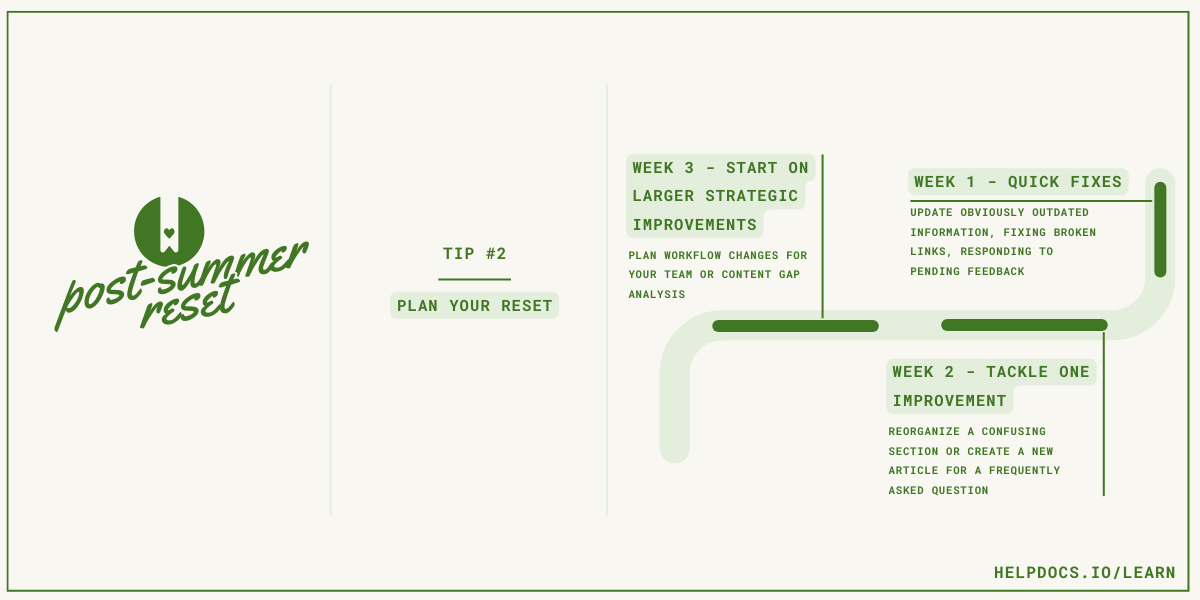
Quick Psychology Hacks for Focus
Use the "Swiss cheese" method: This comes from productivity research on overcoming overwhelm. Instead of trying to complete entire projects in order, poke holes throughout them. Spend 15 minutes updating one section of an article in your HelpDocs editor, then 10 minutes on research for another piece, then 5 minutes organizing your content calendar.
It sounds chaotic, but it's incredibly effective for rebuilding momentum because you're constantly making visible progress across multiple areas.
Create environmental cues for focus: Our brains are surprisingly responsive to environmental triggers. If you did knowledge base work in a certain physical setup before summer, try to recreate that. If you used specific playlists, tools, or even drinks while writing, bring those back too.
This isn't about superstition. It's about leveraging your brain's natural pattern recognition to slip back into productive modes more easily.
Make Your Knowledge Base Antifragile
Nope, we're not just talking about KATSEYE here. As you're rebuilding momentum, let's think beyond just getting back to where you were.
The goal is creating a knowledge base system that actually gets stronger under pressure rather than wilting every time there's a disruption.
Build in Feedback Loops That Actually Work
The most successful knowledge bases aren't just repositories of information—they're living, breathing learning systems.
Set up review cycles that don't depend on perfect conditions or full team availability:
- Monthly mini-audits of your most-visited articles
- Quarterly reviews of search queries that didn't return good results
- Simple feedback collection that actually gets acted on, not just collected
Document Your Own Knowledge Management Knowledge
This is meta, but so important! Create simple guides for your future self and team members. Create guides about:
- How to quickly audit content performance using your analytics dashboard
- Your article creation workflow, including who to ask for what information and how to use collaborative editing features
- Common user scenarios and how they map to your content structure
- Integration points between HelpDocs and your other tools (CRM, support software, project management)
Plan for the Next Disruption
Whether it's another summer slump, holiday season, or unexpected busy period, having a plan makes you resilient. This doesn't mean over-engineering everything, it means having simple protocols for maintaining momentum when conditions aren't perfect.
Set up automated reminders for content reviews, create templates for different types of updates, and establish clear ownership so nothing falls through the cracks even when people are juggling priorities.
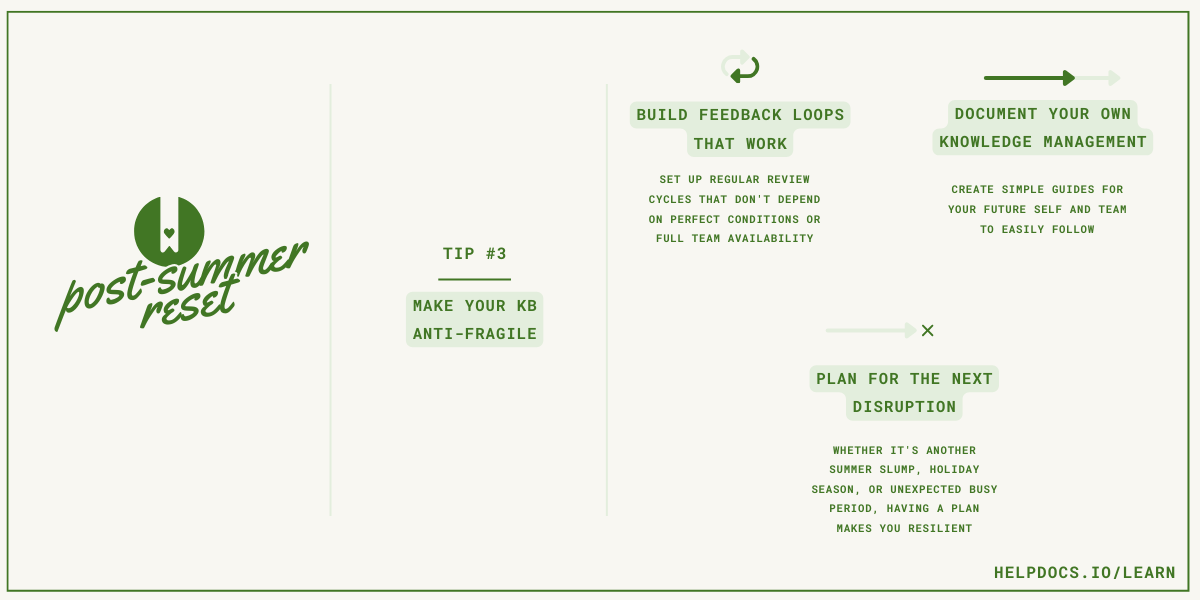
The Compound Effect of Getting This Right
Teams with good knowledge processes spend less time in reactive mode and more time in strategic, creative work.
When your knowledge base is humming along efficiently, you're not constantly fighting fires or answering the same questions repeatedly. You have mental bandwidth for bigger improvements, better user experiences, and more satisfying work. Plus, your users can actually find what they need, and that means fewer support tickets and happier customers all around! ✨
The post-summer reset isn't just about getting back to baseline. It's about using this natural transition point to level up your entire approach.
Your Post-Summer Reset Action Plan
Ready to turn that summer slump into autumn momentum? We've got you covered! Here's your practical starting point:
This week (2-3 hours total):
- Export and analyze 3 months of data from your analytics dashboard
- Identify your top 5 most problematic content areas (high traffic + negative feedback)
- Pick one small, fixable issue and resolve it completely
Next week (1-2 focused sessions):
- Review your content creation workflow and identify the biggest bottleneck
- Test one AI-assisted content improvement using an AI (rewrite, restructure, or draft something new)
- Set up a simple monthly review process for your most important articles
This month (weekly check-ins):
- Create documentation for your own knowledge management process
- Plan your Q4 content priorities based on what you learned from the data
- Establish one new feedback loop to keep you connected to user needs
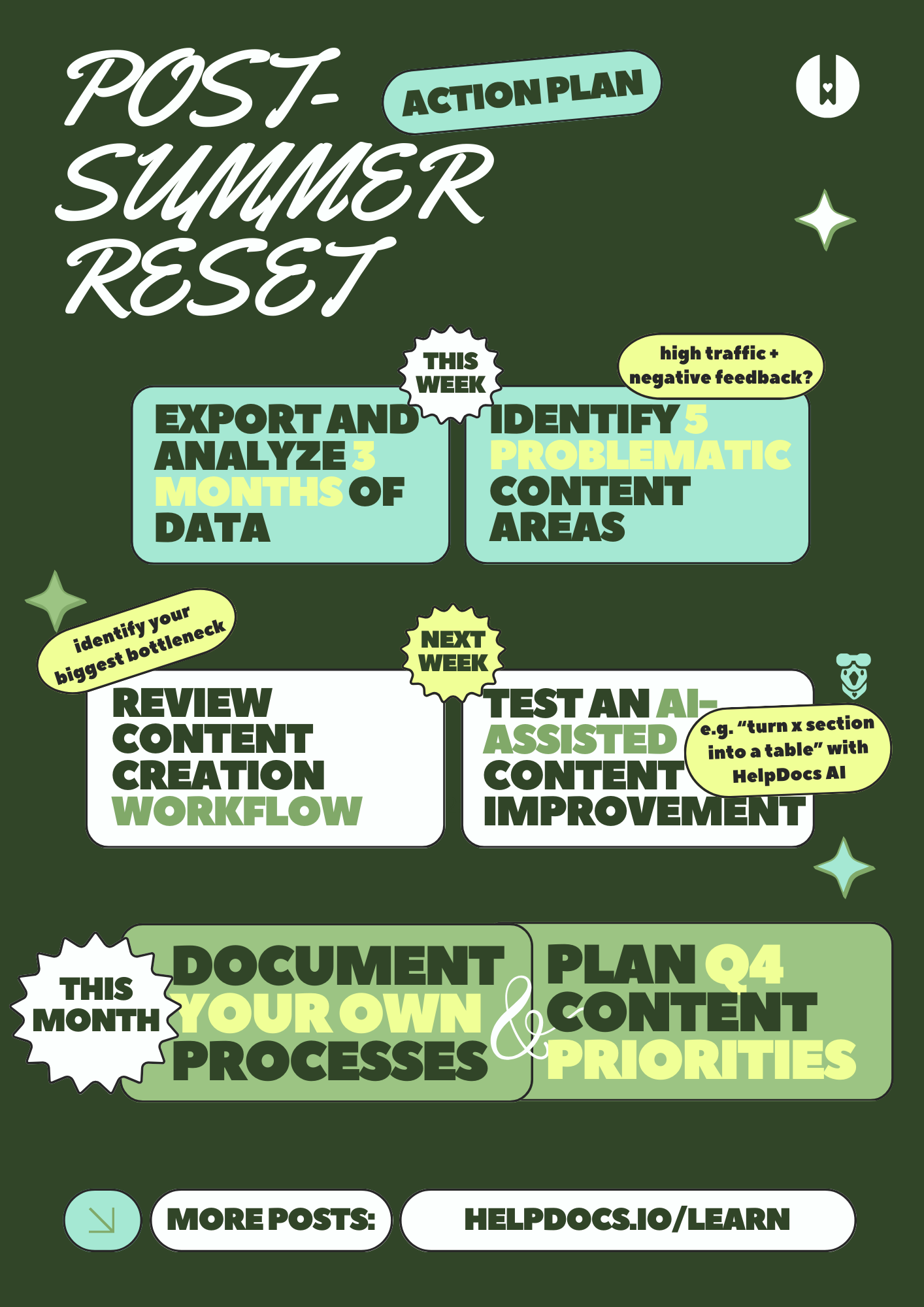
The summer slump happens to all of us. You're definitely not alone in this! But teams that use it as a reset opportunity rather than just waiting for things to naturally improve? Those are the ones that end up with knowledge bases that truly serve their users and make their own lives so much easier.
Your knowledge base is ready for its comeback tour. The question is: are you ready to be its tour manager? 🎤